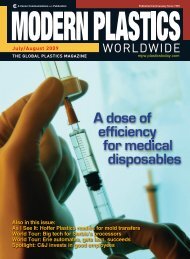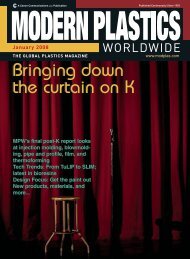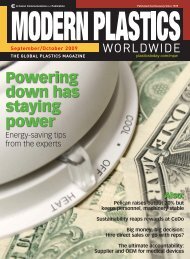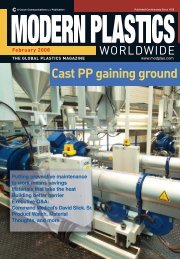amidiq - dae uptlax
amidiq - dae uptlax
amidiq - dae uptlax
Create successful ePaper yourself
Turn your PDF publications into a flip-book with our unique Google optimized e-Paper software.
Conclusions<br />
344<br />
N. Martínez-Vázquez et al. / Revista Mexicana de Ingeniería Química Vol. 6, No. 3 (2007) 337-345<br />
Chemically crosslinked MC/PAAm hydrogels<br />
were prepared in the presence of a crosslinker.<br />
Swelling results indicate that this system’s swelling<br />
behavior follows a second-order diffusion kinetic,<br />
and the swelling process for longer times is not<br />
governed by the diffusion, but by the relaxation of<br />
the polymeric chains. The relaxation of the<br />
polymeric chains can be observed as the vitreous<br />
transition temperature diminishes. The surface<br />
morphology demonstrated fewer crosslink junctions<br />
at 30ºC.<br />
It is clear that the dependence of the swelling<br />
kinetics on the cellulosic derivatives is present in the<br />
hydrogels studied. The rate of swelling is assumed to<br />
be directly proportional to the following two<br />
quantities: first, to the relative or fractional amount<br />
of swelling capacity still available at time t, and<br />
second, to the internal specific boundary area (Sint)<br />
enclosing those sites of the polymer network that<br />
have not yet interacted with water at time t but will<br />
be hydrated and swell in due course. The<br />
polyacrylamide and cellulose networks are held<br />
together by hydrogen bonds and other secondary<br />
valence forces between adjacent polymer chains.<br />
Hydrogen bonds between adjacent polyacrylamide<br />
chains are formed by their amide groups while those<br />
between adjacent cellulose chains are formed by<br />
their hydroxyl and acetal groups. Water swells the<br />
polymer networks because it penetrates between the<br />
chains and breaks interchain secondary valence<br />
bonds by forming hydrogen bonds with hydroxyl and<br />
acetal groups of cellulose, and with amide groups of<br />
gelatin. Rupture of interchain secondary valence<br />
bonds permits the polymer networks to expand to<br />
accommodate the influx of water through relaxation<br />
of the stresses produced by osmotic pressure. The<br />
process is entropy driven (Schoot, 1992).<br />
Acknowledgment<br />
Vazquez Martínez would like to thank the Consejo<br />
Nacional de Educación Tecnológica (CoSNET) for<br />
scholarship no. 402004319MP, and the Dirección<br />
General de Educación Superior Tecnológica<br />
(DGEST) for its support in carrying out the Project<br />
code UR612. Ana Beatriz Morales wishes to thank<br />
the Consejo Nacional de Ciencia y Tecnología for<br />
the support offered by scholarship No.contract<br />
030274.<br />
References<br />
Brandon-Peppas, L., Harland, R. S. (eds). (1990).<br />
Absorbent Polymer Technology. Elsevier,<br />
Amsterdan-Oxford-New Cork-Tokio, 159-<br />
170.<br />
Chen J. and Park K. (2000). Synthesis of Fast-<br />
Swelling, of Superpores Sucrose Hydrogels.<br />
Reviews of Carbohydrate Polymers 41, 259-<br />
268.<br />
Escobar J. L., Agüero L., Zaldivar D., Katime I.,<br />
Rodríguez E. and Ramírez E. (2001). Estudio<br />
de hinchamiento en y la evaluación preliminar<br />
de biocompatibilidad de hidrogeles de<br />
poli(acrilamida-co-ácidometacrílico. Revista<br />
Iberoamericana Polímeros 2 (2), 40-56.<br />
Frusawa H. and Hayakawa R. (1998). Swelling<br />
Mechanism Unique to Charged Gels: Primary<br />
Formulation of the Free Energy. Physical<br />
Review E58, 6145 - 6154.<br />
Grimshaw, P. E., Grodzinsky, A. J., Yarmush., M.<br />
L., Yarmush, A. M. (1990). Selective<br />
Augmentation of Macromolecular Transport<br />
in Gels by Electro-diffusion and<br />
Electrokinetics. Chemical Engineering<br />
Science 45, 2917-2929.<br />
Hirokawa Y. and Tanaka, T. (1984). Volume phase<br />
transition in a nonionic gel Microbial<br />
adhesion and Aggregation. Springer, Berlin<br />
Heidelberg, New York.<br />
Hirokawa, Y., Tanaka, T., y Matsuo, E. S. (1984).<br />
Volume Phase Transition in a Nonionic Gel.<br />
Chemical Physics 81, 6379<br />
Katime I., Katime O., Katime D. (2004). Los<br />
materiales inteligentes de este milenio. Los<br />
hidrogeles macromoleculares: Síntesis,<br />
propiedades y aplicaciones. Ed. Universidad<br />
del País Vasco, 336.<br />
Khare, A. R. and Peppas, N. A. (1995).<br />
Swelling/Deswelling of Anionic Copolymer<br />
Gels. Biomaterials 16, 559-567.<br />
Murali Mohan Y., Keshava Murthy P. S., Sudhakar<br />
H., Vijaya Kumar N. B., Mohana R. K.,<br />
Padmanabha R. M. (2006a). Swelling and<br />
Difussion Properties of Poly(acrylamide-comaleic<br />
acid) Hydrogels: A Study with<br />
Different Crosslinking Agents. International<br />
Journals of Polymerican Materials 55(1) 1-<br />
23.<br />
Murali Mohan Y.; Sudhakar K.; Keshava Murthy P.<br />
S., Mohan Raju K. (2006b). Swelling<br />
Properties of Chemically Crosslinked<br />
Poly(acrylamide-co-maleic acid) Hydrogels.<br />
International Journal of Polymeric Materials<br />
55(7), 513 – 536.<br />
Ohmine, I. and Tanaka, T. (1982). Salt Effects on the<br />
Phase Transitions of Polymer Gels. Journal of<br />
Chemical Physics 77, 5725-5729.<br />
Ortiz, L. E., Morales A. B., Antonio, R., Mendoza,<br />
A. M., Cruz, M. J. (2006). Síntesis y









